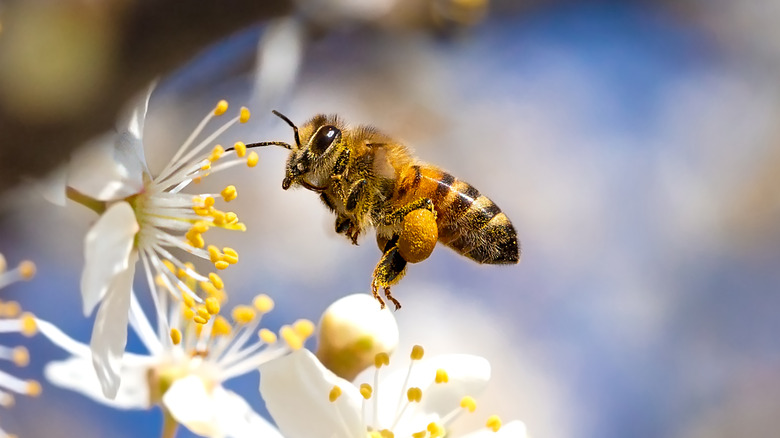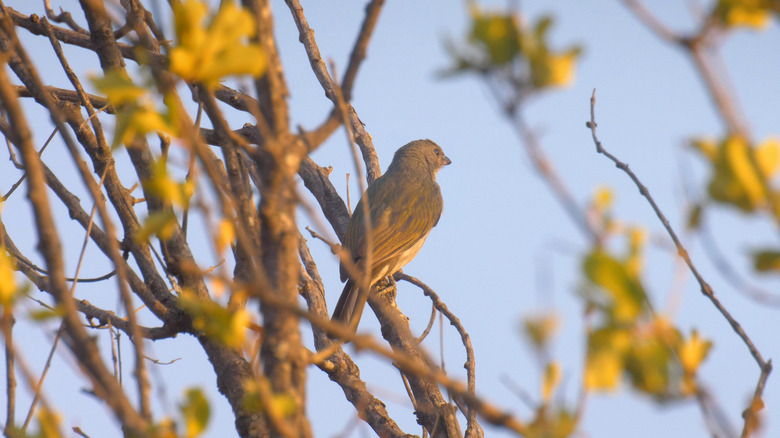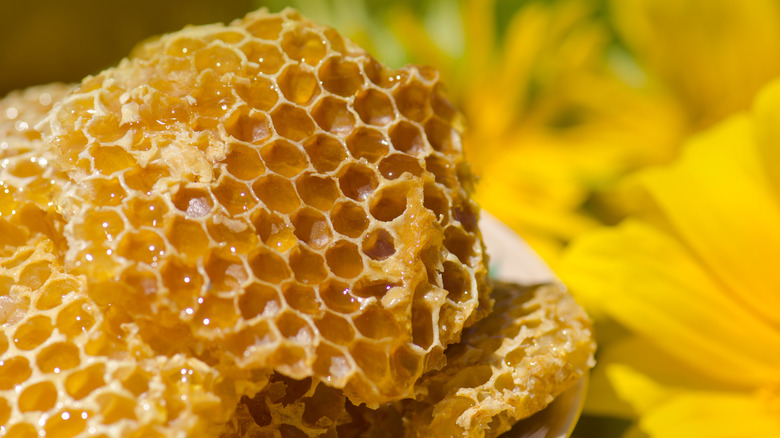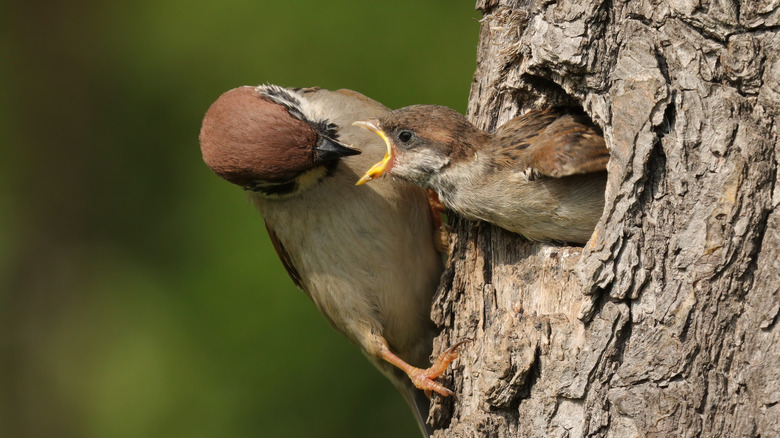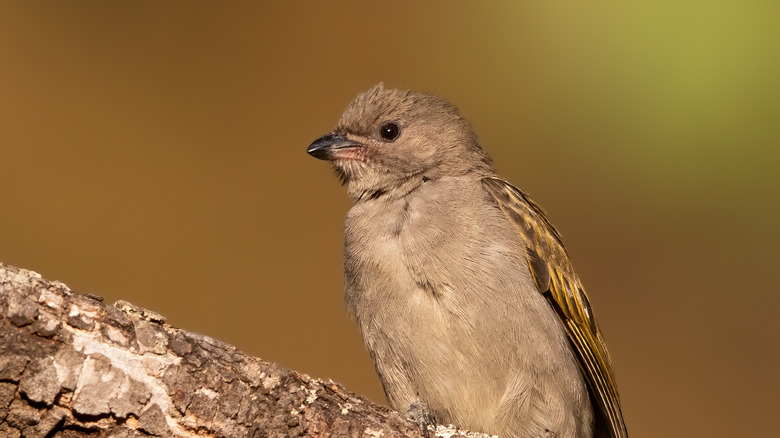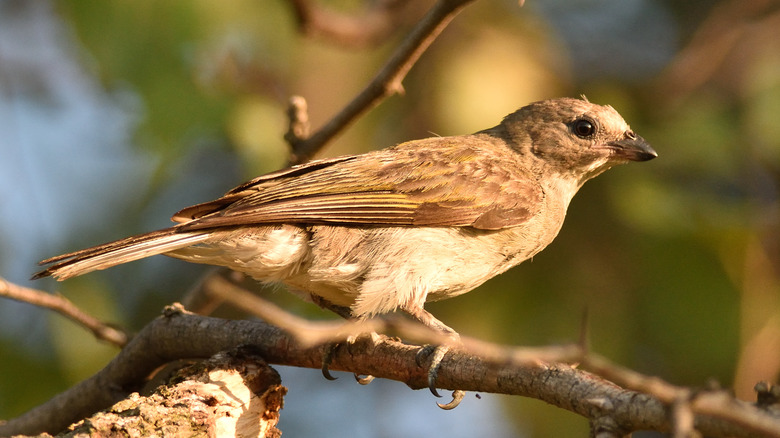Why These Honey Hunters Follow Birds And Not Bees
Birds help the human species thrive in a variety of different ways. Our avian friends disperse seeds in forests to promote plant health and can be used to gauge the health of ecosystems, according to the Audubon Society. They can save potato fields, fruit orchards, and other farmlands from being devoured by insects, serving as a sort of natural pest control. Vultures serve as an all-in-one compost system for the roadkill we produce, and certain seabirds help fertilize agriculture in nearby lands.
Human-bird relationships go back for millenia. Carrier pigeons were used to send messages to allies in wartime. Canaries, as the saying goes, were sent into coal mines to detect carbon monoxide and other toxic gasses before humans could be exposed to them (via Smithsonian Magazine). The ways in which birds help human society and evolution are still being discovered, including one recent way involving another cute winged-creature: bees.
The greater honeyguide
Honey hunters in Africa search for hives to harvest for honey production. Typically, they do this by hoisting a bushel of dried leaves or wood against a hive to smoke out the bees. Then, they chop down the tree and retrieve the honey, bearing a few bee stings along the way (via New York Times). Although that might seem like the hard (and painful) part, what's actually more difficult for the honey hunters is finding the hives in the first place. But instead of following the bees to their hives, honey hunters follow a special bird called the greater honeyguide that helps them track down the nests.
This type of bird is particularly good at smelling wax because they are one of the only species of birds that can eat and digest it (via New York Times, Audubon Society). For the Yao people in Mozambique, the honeyguide bird flutters and tweets in front of honey hunters and leads them to the bees' nests (via Science). After harvesting the honey, the hunters give the beeswax leftovers to the honeyguides as a reward, reinforcing the relationship and giving the birds a taste of their favorite food (per NPR).
How do they communicate?
In Mozambique, one researcher noticed that birds tended to follow honey hunters who cooed and called them with specific tones — sort of like a "brr" followed by a grunt, according to NPR. In a study published in Science, this researcher compared the likelihood of hunters finding honey when playing random sounds that the birds didn't react to as opposed to this traditional sound that she had heard the Yao hunters using with success.
What she found was that using the special calls was responsible for two-thirds of the honey discovered by the hunters, whereas the random calls were responsible for only one third (per Science). One anthropologist told NPR that the honeyguides may have evolved specifically to help people find honey, listening to various sounds they made along the way. Traditionally, the Yao people sometimes even keep the birds hungry on purpose, so that they will be more eager to find the beeswax (per Evolution and Human Behavior).
How do they learn the language?
Greater honeyguides are actually a "brood parasite," which means they are born into the nests of other bird parents, alongside different species of birds, according to the Audubon Society. But they aren't friendly neighbors in the nest. Despite still being blind and feeble, honeyguides will kill the other birds in the nest using the sharp end of their beaks within minutes of being born.
Afterwards, the rightful parents of the nest are forced to raise the parasitic honeyguide as adoptive parents (per Audubon Society). Because of this genetic mismatch, it's clear that the honeyguides don't learn the ins and outs of this complex communicative relationship with humans from their adoptive parents (via the Audubon Society). Instead, researchers think the behavior must be innate with particular birds learning the various calls of their region from the environment — a whistle in Tanzania, or the chopping of wood in Zambia.
The benefits to humans
The practice of harvesting honey has become a widespread fad, with hundreds of thousands of people in the U.S. now keeping their own bees, according to Scientific American. The presence of bees can help farmers through the bees' pollinating powers (per NPR). But the problem with honeybees, originally imported from Europe, is that they can increase competition for other species of native bees, many of which are endangered. Mistakenly, many people think that harvesting honey and keeping bees is somehow helping the environment in the U.S., when in reality it might be threatening some of the native bees.
But for indigenous African communities, it's a different story. The Yao hunters, for example, have access to hunt in the Niassa National Reserve, a protected and sprawling ecosystem the size of Denmark (via Audubon Society). In their harmonious relationship with nature, the partnership provides food security for the birds and the humans, without putting the bees at risk.
Do other birds do this?
You might think you are able to communicate with your dog or cat at home, but this degree of human and animal interaction in the natural world is nearly unheard of. According to the Audubon Society, the communication between African communities and the honeyguides is the only such example of a successful back-and-forth signal between humans and an animal in the wild.
Though some others come close. Dolphins, for example, have been shown to help fishermen by rounding up catches in places like Laguna, Brazil (via Science). Orcas have also been shown to help whalers kill whales by tugging on casted cables and drowning them. And in turn, the whalers give the orcas the whale's tongue as a treat for their service (per New York Times). But this degree of communication between honeyguides and humans, with something to be gleaned for everyone involved, is truly unmatched.
